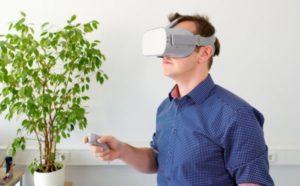Robot Safety
Robots rock: How top trends from the edge of technology can transform health and safety
With a particular interest in systems and Connected Safety – the application of IoT and AI in helping to make the world a safer place – John Kersey brings his expertise and insights from the edge of safety technology, to review five major technology trends that will have a major impact on health and safety professionals in the very near future.
John Kersey is author of SHP’s ‘Robot Safety series’, and is also a member of the SHP advisory panel; and contributor and presenter at the Safety & Health Expo. John is an experienced safety professional, and currently HSEQ Business Partner for ISS UK, part of the ISS global facility services management company.
John began his recent Safety & Health Expo seminar by conjuring up a traditional image for the audience – of safety professionals going about their job, complete with clipboard and checklist, by saying “No more clipboards!” This demonstrates how technology is eradicating traditional paper-based systems and moving swiftly towards complete document process automation within organisations. In this context, safety compliance checks are now done by IoT devices – any violations are then sent to supervisors via alerts.
- Mixed reality
 Head monitored displays; augmented reality; and virtual reality devices are all becoming common tools within health and safety roles. Immersive technology such as this creates a great format for storytelling: stories can be a very powerful instrument to use within a training environment.
Head monitored displays; augmented reality; and virtual reality devices are all becoming common tools within health and safety roles. Immersive technology such as this creates a great format for storytelling: stories can be a very powerful instrument to use within a training environment.
To support this area of development, a series of government funded projects are available via StoryFutures. Both Brunel University London and Royal Holloway University are undertaking projects in this area, with the assistance of grants.
- Vision systems
Ideal for safety applications such as monitoring employees’ use of PPE: a screen can highlight compliance, for example, in simple terms via green graphics which denote compliance, whilst red graphics denote non-compliance.
Other systems being developed and refined include facial recognition systems; systems using biometric markers to measure gait; and non-biometric markers which can monitor apparel.
- Enhanced analytics
The development and enhancement of devices means that more data is produced, which in turn creates more opportunities for insightful – and predictive – analysis: ‘insight driven management’ and ‘insight driven organisations’ (IDO) are growing business trends.
Enhanced analytics displayed in 3D graphic format e.g. as graphs and statistics, can be a particularly useful visualisation tool for predictive analytics. John succinctly described this as ‘dashboard storytelling’.
Illustrating current adoption levels, John referenced a Verdantix survey which forecasted that 59% of respondents are already employing enhanced analytics technology.
- Adoption of design thinking
Because technology is fast becoming a primary driver for change, so workplace cultures and approaches will also change: one example being that adopting design sprint will not only become more prevalent but also more widely used i.e. in non-tech settings.
These different, more innovative ways of approaching work and solving problems will have a re-energising effect on the health and safety profession, especially for those businesses and employees with an appetite for change.
- Standards and accountability
John used the analogy that businesses are at the moment mostly in ‘Wild West’ territory i.e. largely unregulated. However, some regulatory guidelines exist: the Code of Practice for Consumer IoT Security (aimed mainly at domestic users); BSI’s research report The Requirement for Standards in the VR and AR Sectors. In America, the IoT Cyber Security Improvement Act is going through Congress currently.
And finally, into the future
John concluded this very engaging session by asking: “Are you the health and safety professional of tomorrow?” – in other words, are you a future shaper i.e. embracing the technology trends that can transform your profession?
To read about this in more detail, click here.
Robots rock: How top trends from the edge of technology can transform health and safety
John Kersey brings his expertise and insights from the edge of safety technology, to review five major technology trends that will have a major impact on health and safety professionals in the very near future.
Caroline Smith
SHP - Health and Safety News, Legislation, PPE, CPD and Resources Related Topics
UK energy sector unites for AI and digitalisation
Higher demand but not able to meet it – survey finds health and safety provision lacking for staff
How will AI transform health and safety?

 Head monitored displays; augmented reality; and virtual reality devices are all becoming common tools within health and safety roles. Immersive technology such as this creates a great format for storytelling: stories can be a very powerful instrument to use within a training environment.
Head monitored displays; augmented reality; and virtual reality devices are all becoming common tools within health and safety roles. Immersive technology such as this creates a great format for storytelling: stories can be a very powerful instrument to use within a training environment.